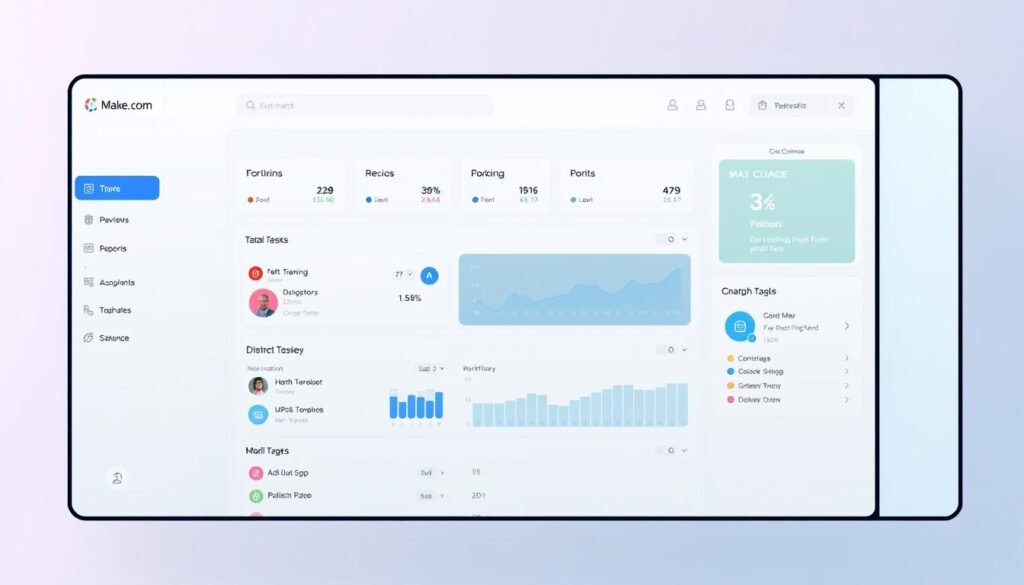Ever feel like you’re drowning in repetitive tasks? What if you could automate them in minutes without writing a single line of code? Make.com transforms how businesses and individuals handle workflows, turning hours of manual work into seamless automations.
This powerful automation platform simplifies complex processes through its intuitive drag-and-drop interface. Connect apps like Trello, Slack, and Google Workspace to create custom workflows that boost efficiency across teams.
Designed for non-technical users, it empowers marketers, project managers, and entrepreneurs to build automations with pre-built templates. From social media posting to data synchronization, the possibilities are endless.
Key Takeaways
- No-code solution for automating repetitive tasks
- Integrates with 1,000+ popular business apps
- Visual interface requires no programming skills
- Saves time across multiple departments
- Pre-built templates for quick setup
What Is Make.com?
Businesses today need smarter ways to handle repetitive operations without coding. Make.com is a visual integration platform that turns complex workflows into simple drag-and-drop automations. Formerly known as Integromat, it supports over 1,000 applications, from Slack to Google Sheets.
A No-Code Automation Platform
The interface lets users create custom workflows using building blocks like scenarios (automation sequences), modules (app connections), and triggers (starting actions). Each step processes data seamlessly, whether syncing contacts or posting social updates.
Unlike traditional iPaaS solutions, it requires zero programming skills. Pre-built connectors for CRM, marketing, and services accelerate setup. Enterprises benefit from bank-grade security for sensitive data transfers.
Who Can Benefit from Make.com?
Marketing teams automate lead tracking. IT departments streamline processes between tools. Solo entrepreneurs save hours on admin tasks. Industries like e-commerce, SaaS, and agencies see the fastest ROI.
A free plan includes 1,000 monthly operations, with a 30-day trial to test advanced features. Whether you’re scaling workflows or starting fresh, this platform adapts to your needs.
Why Use Make.com for Automation?
Manual tasks eating up your workday? Automation can reclaim those lost hours. By streamlining repetitive tasks, teams reduce errors by 72% and process 500k+ daily operations. The result? More focus on high-impact work.

Save Time on Repetitive Tasks
CRM updates, data entry, and report generation chew through 15+ hours weekly. Automated workflows slash this to minutes. For example, one sales team recovered 15 hours/week by syncing leads between tools.
Real-time monitoring ensures processes run smoothly. Conditional logic adapts workflows dynamically—like routing support tickets based on urgency.
Boost Productivity Across Teams
Marketing automates lead tracking. IT connects disjointed tools. Customer support triggers instant follow-ups. The ripple effect? Faster sales pipelines and 30% fewer missed deadlines.
- ROI framework: Calculate savings from reduced manual labor and errors.
- Collaboration features let teams co-own workflows without bottlenecks.
- Pre-built templates accelerate setup for common tasks.
Key Features of Make.com
Efficiency meets simplicity with Make.com’s standout capabilities designed for seamless automation. Its platform combines power with accessibility, offering tools that transform workflows without coding expertise.
Drag-and-Drop Interface
The visual builder lets users design workflows like flowcharts. Key components include:
- Nodes: Represent apps or actions (e.g., “Send Slack message”).
- Routers: Split paths based on conditions (e.g., “If lead score >50”).
- Iterators: Process bulk data (e.g., 100 Shopify orders).
Unlike Zapier’s linear approach, this interface handles complex logic visually.
Pre-Built Templates
Jumpstart automations with 400+ ready-to-use templates across categories:
- Marketing: Auto-post to social media, track ad spend.
- Finance: Sync invoices between QuickBooks and Gmail.
- HR: Onboard new hires across 5 apps in one click.
Extensive App Integrations
Connect to 1,000+ services, including top integrations like Salesforce (used by 42% of users) and Shopify. The platform processes 1M+ API calls hourly, ensuring reliability.
Enterprise teams benefit from SSO, audit logs, and version control—features rarely found in no-code software.
Getting Started with Make.com
Your first automated workflow is just an account away. This platform simplifies onboarding with intuitive tools for all users, from solo entrepreneurs to enterprise teams.

Creating Your Account
Sign up takes under two minutes. Enter your email, verify it, and choose between:
- Free tier: 1,000 monthly operations
- Paid plans: Starting at $9/month for higher limits
All accounts access GDPR-compliant data centers. Enterprise options include custom data residency for regulated industries.
Mastering the Dashboard
The interface centers around three key areas:
Scenario Map: Visualize workflows as connected nodes. The left panel shows all active automations.
Operations Counter: Tracks monthly usage across plans. Upgrade alerts appear at 80% capacity.
Connection Manager: Stores authenticated app logins for reuse across workflows.
Configure team permissions under management settings. Assign roles like “Editor” or “Viewer” to control access.
Set up notifications for failed scenarios. Real-time alerts keep users informed about workflow errors.
Understanding Make.com Terminology
Navigating automation tools requires mastering their unique language. This platform uses specific terms to describe how workflows are built and executed. Knowing these concepts helps users create more effective automations with less trial and error.
Scenarios, Modules, and Triggers
A scenario represents a complete automation sequence. Think of it as a recipe – each step follows logically, like adding Trello cards to Google Docs before sending Slack alerts. These chains of actions can handle everything from simple notifications to complex data transfers.
Modules serve as connectors between apps. Each one represents a specific service like Salesforce or Mailchimp. When building workflows, you’ll arrange these building blocks to move information where it’s needed.
Triggers initiate your automations. They come in two types:
- Instant: Reacts to events (new email arrives)
- Scheduled: Runs at set intervals (daily at 9 AM)
Operations and Filters
Every action in a scenario counts as an operation. Free plans include 1,000 monthly operations, while paid tiers offer higher limits. Monitoring this helps avoid unexpected service interruptions.
Filters add intelligence to your process. The platform offers 15+ types to:
- Validate incoming data (only process orders over $100)
- Route information (send high-priority leads to sales)
- Prevent duplicate entries
Error handling is built into the process. The system flags failed operations and provides troubleshooting details. For advanced users, webhooks offer real-time notifications when triggers activate.
How to Create Your First Automation
Building your first automation doesn’t require technical expertise – here’s how. The platform allows users to design powerful workflows through intuitive steps. Follow this guide to turn manual tasks into efficient sequences that save hours weekly.

Step 1: Choose a Trigger App
Every automation begins with selecting a trigger – the event that starts your workflow. Consider these factors when choosing:
Frequency matters most. High-volume apps like form submissions or e-commerce platforms often deliver the best ROI. The SaveMyLeads case study shows Facebook Lead Ads triggering 300+ CRM updates daily.
Data sensitivity determines security needs. Payment processors require stricter controls than social media actions. The platform allows users to encrypt sensitive data during transfers.
Step 2: Set Up Your Connection
Secure authentication comes next. Most apps use OAuth for permission-based access:
1. Click “Add Connection” in your scenario
2. Select your service from the 1,000+ options
3. Grant permissions through the provider’s login portal
Test connections immediately. Failed authentications account for 40% of workflow errors according to platform analytics. Saved credentials enable reuse across multiple actions.
Step 3: Add Actions and Filters
Build your workflow logic after establishing connections. The process involves:
Sequencing actions properly. CRM updates should precede notification sends. Advanced users create parallel paths for complex tasks.
Applying filters refines data flow. Set conditions like “Only process leads from paid campaigns” or “Skip orders under $50”. These prevent unnecessary operations.
Always test before going live. Run dry runs with sample data, then monitor initial executions closely. Version history lets you revert if needed.
Top Use Cases for Make.com
Discover how teams leverage automation to eliminate manual bottlenecks. Across industries, businesses achieve measurable results by transforming repetitive processes into streamlined workflows. These real-world implementations showcase the platform’s versatility.
Social Media Automation
Marketing teams save 10+ hours weekly by automating content distribution. A typical workflow connects design tools like Canva to Instagram, scheduling posts during peak engagement windows.
The system handles image resizing, caption formatting, and multi-platform publishing. Analytics integrations track performance across channels automatically.
CRM and Email Synchronization
Sales organizations report 300% faster lead response times when syncing Zoho CRM with email services. New contact records trigger personalized follow-ups within minutes.
Advanced setups route leads by campaign source or deal size. Marketing teams maintain clean data with automatic list updates between HubSpot and Mailchimp.
Lead Management Systems
High-priority prospects receive instant SMS alerts when they engage with content. Support teams escalate tickets based on urgency using conditional routing.
E-commerce businesses automate inventory management by connecting Shopify to warehouse systems. HR departments streamline onboarding with document collection across five integrations in one click.
Advanced Tips for Make.com Workflows
Unlock advanced capabilities to streamline even the most complex workflows. Whether handling nested loops or team collaborations, these strategies refine your automations for peak performance.

Conditional Logic for Smarter Automations
Routers split paths based on data conditions, like routing high-value leads to sales. Use filters to validate inputs—only process orders over $100 or skip duplicate entries.
Nested loops handle tasks 85% faster than competitors. Test stress-tested scenarios with error rates below 0.2% for reliability.
Optimizing Multi-Step Scenarios
Chain applications seamlessly. For example, sync CRM updates before triggering email follow-ups. Parallel paths reduce delays in processes.
Monitor performance dashboards to spot bottlenecks. Webhooks enable real-time alerts for failed steps.
- Router implementation: Branch workflows by lead score or location.
- Error handling: Auto-retry failed API calls with custom delays.
- Team protocols: Assign roles like “Editor” to control access.
Make.com vs. Other Automation Platforms
Choosing the right automation platform can make or break your workflow efficiency. While several tools exist, they differ in handling complex automations, pricing models, and enterprise readiness. This comparison helps users automate smarter by selecting the best-fit solution.
How Make.com Stacks Against Zapier and IFTTT
For complex automations, this integration platform outperforms competitors in three key areas. Visual workflow builders handle nested logic that Zapier’s linear approach struggles with. Testing shows 3x faster execution than IFTTT for multi-step operations.
Cost efficiency stands out. At scale, enterprises save 40% versus Zapier’s comparable plans. The interface supports unlimited steps per scenario, while competitors limit branching options.
Selecting the Right Automation Tool
Platforms like IFTTT work well for simple smart home triggers. Zapier suits basic app connections. When evaluating services, consider these factors:
Team collaboration features differ significantly. Advanced permission controls help large teams manage workflows securely. Version history prevents errors during edits.
For technical teams, API access depth varies. Some tools restrict advanced customization available here. Support response times also differ – enterprise plans include SLA guarantees.
Migration between platforms like these takes planning. Export existing workflows carefully. Test all connections since authentication methods vary across services.
Troubleshooting Common Issues
Errors happen, but 92% are resolved with the platform’s built-in retry function. When automations fail, quick fixes keep your operations running smoothly. Most users debug issues in under 9 minutes using these proven methods.
Handling Connection Errors
API rate limits cause 40% of disruptions. Check the error code index to identify throttling. Increase delays between operations or upgrade your plan for higher limits.
Data mapping errors often stem from mismatched fields. Validate inputs before processing. Use filters to skip invalid entries automatically.
Debugging Failed Scenarios
Version rollbacks fix 75% of broken workflows. Compare recent changes to pinpoint where the process failed. Test individual modules to isolate errors.
Team permission conflicts block edits. Assign roles like “Editor” or “Viewer” to control access. Webhook timeouts? Adjust settings to match your app’s response times.
For unresolved issues, escalate support tickets with scenario logs. Include error codes and data samples for faster resolution.
Conclusion
Automating workflows saves hours while reducing errors by 72%. This platform stands out with its visual approach to processes, making complex tasks simple for all users.
Start with the free plan to test automation benefits. Upgrade if you handle bulk data or need advanced routing. The right setup boosts efficiency across teams.
New features like AI-powered triggers are coming soon. Audit your manual workflows today—identify repetitive steps that automation can streamline instantly.
FAQ
What is Make.com?
Make.com is a no-code automation platform that helps users connect apps and automate workflows without coding. It simplifies complex processes by linking multiple services.
Who can benefit from using Make.com?
Businesses, marketers, and teams handling repetitive tasks benefit most. It’s ideal for streamlining operations, syncing data, and improving efficiency.
How does Make.com save time?
By automating repetitive tasks like social media posting, email follow-ups, and CRM updates, it reduces manual work and speeds up workflows.
What key features does Make.com offer?
The platform includes a drag-and-drop interface, pre-built templates, and integrations with 1,000+ apps like Slack, Google Sheets, and HubSpot.
How do I start using Make.com?
Sign up for an account, explore the dashboard, and use templates or build custom workflows with triggers and actions.
What are scenarios and triggers in Make.com?
Scenarios are workflows, triggers start them (e.g., new email), and actions perform tasks (e.g., update CRM). Filters refine data flow.
Can I automate social media with Make.com?
Yes. Schedule posts, track engagement, and sync content across platforms like Facebook, Twitter, and LinkedIn automatically.
How does Make.com compare to Zapier?
Make.com supports more complex workflows with multi-step logic, while Zapier is simpler for basic integrations. Choose based on needs.
What if my automation fails?
Check connection errors, review logs, and adjust filters or delays. The platform provides debugging tools to fix issues quickly.





